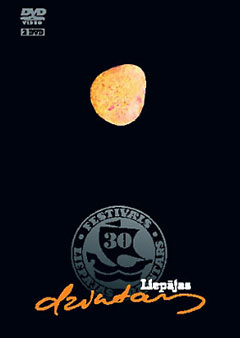
Rare is the town in Latvia that so actively promotes itself as a place of music as does Liepāja. In guide books, marketing materials and brochures, Liepāja goes out of its way to remind readers of the importance of music and how very many musicians come from there, not to mention that it is the home of the always excellent Liepāja Symphony Orchestra. Along with the beach, the sea and, of course, the prison, music is one of the most compelling aspects of visiting Liepāja. Who can argue, when even composer Imants Kalniņš (among many others) states that Liepāja is the rock music capital of Latvia—not even Riga can compete.
Because it is home to so many great musicians and so much great music, it seemed only natural that an almost yearly music festival would be held in Liepāja. Appropriately dubbed Liepājas dzintars, the festival began in 1964 and celebrated its 30th anniversary in 2006 with a massive concert. In honor of this long-running tradition, MICREC at the end of 2007 released a two-DVD set celebrating the festival. The exhaustive collection features one disc with various performances throughout the years, as well as a short documentary feature on the festival. The second disc collects highlights of the 30th anniversary show.
The first DVD offers many fascinating glimpses of noteworthy and perhaps lesser known artists performing at the festival. The bulk of the clips are from 1991 and later, but there are plenty of interesting older clips, such as “Baletomānija” performed in 1987 by the Ensemble of the Region of Tukums (so called because the band at the time could not go by its real name: Pērkons). There is singer Ieva Akurātere’s historic and moving performance of “Manai tautai” from 1988, with many in the audience singing along and in tears. Particularly interesting is an all-too-brief clip from 1964 of the group Zvaigznīte (featuring Uldis Stabulnieks on piano and Gunārs Rozenbergs on trumpet) performing “Rotaļa.” And, of course, there is the inevitable performance of the Liepāja anthem, “Pilsētā, kurā piedzimst vējš,” performed by Menuets in 1994. I’ll probably have all of Liepāja breaking down my door for this, but I really could do without hearing the song for a long while. The title is repeated way too many times in the song for my tastes.
It is not just Latvian artists who performed at Liepājas dzintars. Many international artists appeared, too, including Dva Samoļota from Russia, performing “Bambula” in 1991; Mciri from Georgia performing a folk song in 1991; the New Murphy Band from Estonia performing “Let’s Twist Again” in 1992, and Išjunk Švieša from Lithuania performing “Opapā” in 1994.
Children get into the act as well. Children’s group Auri performed “Melanija” in 1991 (featuring Lauris Reiniks, who, although maybe at most 10 years old at the time, already had a breathtaking mullet). The Children of Liepāja in 1992 performed “Vīrs ar vijoli.”
At just under an hour, the documentary Es būšu, ja tu būsi (I Will Be There, If You Are There) is a very short overview of the history of the festival, including clips from interviews with many of the artists and the composers of Liepāja. The film is in Latvian with no subtitles and is directed by Svetlana Rudzīte.
I must say that one of the first things that strikes you when viewing the documentary is how old everyone looks now. Tumsa’s lead singer, Mārtiņš Freimanis, in his early 30s, is by far the baby of the bunch. Since the documentary is so short, it is too brief to do a proper history of the event, and limits the artists to rather brief sound bites. Overall, the documentary is slightly unfocused. But there are plenty of interesting tidbits, such as Freimanis recalling his pants getting pulled off at a concert, as well as Valdis Vikmanis, the former director of the Leipāja School of Music, giving his impressions of composer Imants Kalniņš as a student. Zigfrīds Muktupāvels, singer for Zodiaks and bet bet, also tells a story of how while he was a student in the music school (and, as he puts it, not a particularly good student), Vikmanis gave him a ruble to get some food since he was tall and thin and needed to keep his stomach working.
And that’s just the first DVD. The second DVD has highlights of the 30th anniversary show. Many of the performances are backed up by the Liepāja Symphony Orchestra, including the winner of the Best Vocalist award at the very first Liepājas dzintars in 1964, singer Zdislavs Romanovskis, who sings “Baltijas jūra.” Many performers and award winners at previous Liepājas dzintars festivals returned for the anniversary concert, including Zodiaks performing “Taisnība,” Credo performing “Sāpe,” Menuets performing “Alvas zaldātiņi,” Pērkons performing “Kamēr es tevi mīlēju” and Līvi performing “Dzelzsgriezējs.”
Sound and video quality is generally good, but on the first DVD, due to the fact that much of the footage is very old, the video is often grainy and the audio also uneven. Sadly, not all years were recorded or archived, so there are many great performances at the festival that are lost forever. Though I would like to have seen more clips from before 1991, the overview is still very thorough. On subsequent viewing, I usually skip over the children’s acts, the non-Latvian acts and some of the lesser songs—composer Uģis Praulinš, performing with the group Vecās mājas in 1991, and Ivo Fomins, performing with the group Libau in 1992, would go on to far bigger and better things.
It is hard to believe that even at two full DVDs, this is just the tip of the iceberg. Liepājas dzintars is one of the most important and longest running music festivals and this two-DVD set amply collects many of the highlights of this significant Latvian event.
Details
Liepājas dzintars
Various artists
MICREC, 2007
MRDVD012




